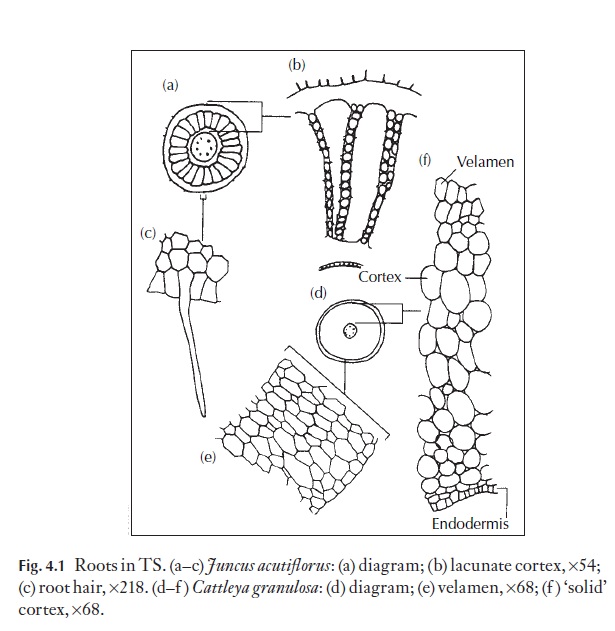Chapter: Plant Anatomy:An Applied Approach: The root
Cortex - Root
Cortex
The cortex is sufficiently variable to be used to assist in identification. Un-fortunately, from that point of view, the various types of cell arrangement seem to have more ecological than systematic significance.
Two basic types of cortex are recognizable among other, less frequent, variations. These are the ‘solid’ and the ‘lacunate’ cortex (Fig. 4.1). The ‘solid’ cortex is composed of parenchymatous cells which are relatively compact, with intercellular spaces confined to the angles between cells. It is usual for there to be a gradual increase in the size of such cells from the outer to the inner layers, but the innermost few layers are frequently of a smaller and more compact type of cell. Such an arrangement is common in both monocotyledon and dicotyledon roots on plants which grow in well-drained soil types. The ‘lacunate’ cortex has a few outer layers of compactly arranged cells and the innermost layers may be similarly compact. Between these, radiating plates of cells are seen in TS, with large air spaces between them (Fig. 4.2). In TLS these may be seen as longitudinal plates, but more commonly they are arranged in a net-like pattern, thus enclosing the air cavities or lacunae. Diaphragms of stellate (literally star-like cells with ra-diating thin arm-like protrusions) and other cell types may traverse the la-cunae, as in the stem. Most plants with this type of root cortex have their roots in soil which is periodically waterlogged, or even immersed in water. The condition can be induced in Zea, which normally lacks lacunae, by growing the plants in waterlogged soil.

The number of layers of cells in a cortex can vary in specimens of a given species, but within bounds. It might be possible to distinguish between species in a genus if some of them have many layers and others few, but this is not a very sound exercise.

Sclereids, fibres, tannin cells, mucilage cells and crystal containing cells can be found scattered in the parenchymatous cortical tissue in a wide range of families. Their presence and distribution can be helpful in nar-rowing down possibilities for identification, but are rarely of taxonomic significance.
Related Topics